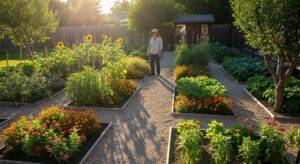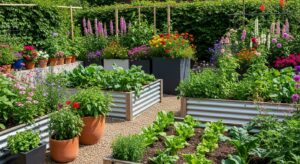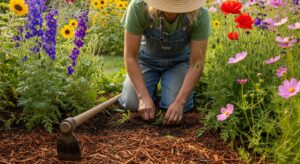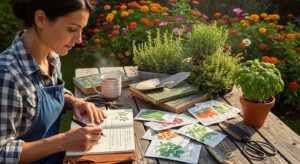There’s something truly magical about stepping into a garden that you’ve nurtured yourself. Whether it’s a balcony filled with colorful blooms, a backyard vegetable patch, or a serene corner with fragrant herbs, a garden reflects both your personality and care.
But creating and maintaining a garden you’ll love doesn’t happen by chance; it takes planning, patience, and a few smart strategies.
Here are some top tips to help you grow a thriving garden that blossoms into success.
1. Start with the Right Location

The foundation of any great garden is its location. Most plants need at least 6–8 hours of sunlight per day, though shade-loving plants like ferns or hostas thrive in lower light. Before planting, spend a few days observing how sunlight and shade move across your space.
-
Tip: Group sun-loving plants together in the brightest spot.
-
Bonus: Consider accessibility, choose a location that’s easy to water, weed, and enjoy daily.
2. Know Your Soil

Healthy soil is the lifeblood of your garden. Conduct a simple soil test to check for pH balance and nutrient levels. Most flowers and vegetables thrive in soil that is rich, well-draining, and slightly acidic to neutral.
-
Amendments: Add compost, organic matter, or mulch to boost fertility.
-
Drainage check: After heavy rain, observe if water pools. If so, consider raised beds or containers.
When your soil is healthy, your plants will naturally flourish.
3. Choose Plants You Love (and That Fit Your Space)

The most successful gardens are filled with plants that bring joy. Think about what excites you most. Do you dream of colorful flowers, fresh vegetables, or fragrant herbs?
-
For color: Marigolds, zinnias, or roses.
-
For food: Tomatoes, peppers, or salad greens.
-
For fragrance: Lavender, mint, or jasmine.
Also, match plants to your climate and the space you have. A small patio can host a thriving herb garden in containers, while larger yards can accommodate sprawling vegetable beds.
4. Water Wisely

Water is essential, but overwatering can be just as harmful as underwatering.
-
Best practice: Water deeply but less frequently to encourage strong root growth.
-
Morning is best: This allows leaves to dry during the day, preventing disease.
-
Tools: Use soaker hoses or drip irrigation for efficiency.
Consistency is key. Plants thrive when their watering schedule is reliable.
5. Feed for Strong Growth

Even the best soil needs occasional support. Fertilizers, compost, or organic amendments can give your plants a boost.
-
Vegetables: Benefit from nitrogen-rich fertilizers for leafy greens and potassium for fruiting crops.
-
Flowers: Thrive on balanced, all-purpose fertilizers.
-
Organic option: Homemade compost tea or worm castings add nutrients naturally.
Feeding helps plants resist disease, produce more blooms, and deliver a bountiful harvest.
6. Keep Weeds Under Control

Weeds compete with your plants for water, sunlight, and nutrients.
-
Prevention: Use mulch to suppress weed growth while keeping soil moist.
-
Routine: Spend a few minutes each week pulling small weeds before they take over.
-
Tools: A hand hoe or weeder makes the job quicker.
Consistent weeding keeps your garden neat and plants healthy.
7. Embrace Seasonal Care

A thriving garden changes with the seasons. Be ready to adapt.
-
Spring: Focus on soil preparation and planting.
-
Summer: Prioritize watering and feeding.
-
Fall: Plant cool-weather crops or bulbs for spring.
-
Winter: Protect perennials with mulch or covers.
By syncing your efforts with the seasons, your garden will stay lively year-round.
8. Add Personal Touches

A garden isn’t just about plants, it’s about creating a space you love. Add decorative touches to make it uniquely yours.
-
Ideas: Bird baths, garden gnomes, stepping stones, or trellises.
-
Function + Beauty: A bench or hammock can make your garden a relaxing retreat.
-
Lighting: Solar-powered lights highlight plants at night, extending enjoyment.
These little details transform a garden from ordinary to extraordinary.
9. Practice Patience and Consistency

Gardening is a journey, not a race. Plants take time to grow, bloom, and bear fruit.
-
Tip: Celebrate small wins, like your first bloom or ripe tomato.
-
Consistency matters: Regular watering, feeding, and pruning lead to lasting success.
Patience turns gardening into a rewarding and mindful hobby.
10. Learn as You Grow

Every gardener makes mistakes, and that’s part of the beauty. Some plants may fail, while others thrive beyond expectations.
-
Keep notes: Track what works well each season.
-
Seek advice: Join local gardening groups or online communities.
-
Experiment: Try new plants or techniques each year.
Learning makes your gardening journey more enjoyable and successful.
Final Thoughts
Gardening isn’t just about growing plants—it’s about growing joy, peace, and a space you truly love. By choosing the right location, nurturing your soil, watering and feeding wisely, and adding personal touches, you can create a thriving garden that reflects your care and creativity.
With these top tips for blossoming success, your garden will become more than just greenery; it will be your sanctuary, your pride, and your inspiration.